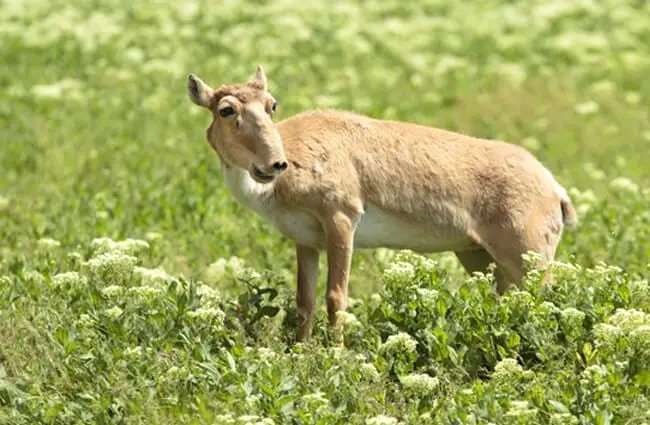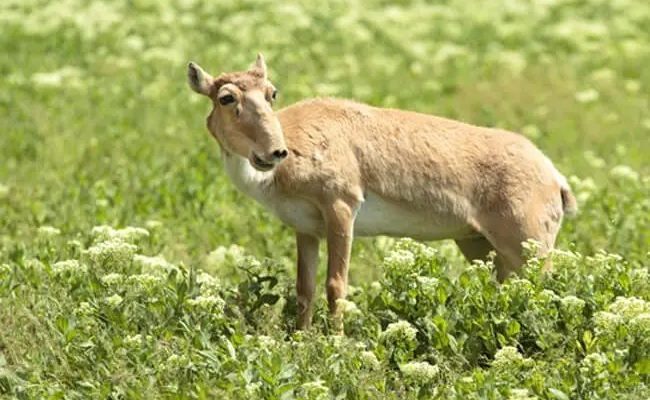
You might be surprised to learn that Saiga antelopes are herbivores, but their feeding behavior is anything but ordinary. These animals roam the vast grasslands of Central Asia, constantly on the lookout for food. Understanding their diet and how they outsmart predators can give us insight into the delicate balance of life in their ecosystem. So, let’s take a closer look at what they eat and how they navigate the challenges of survival.
What Do Saiga Antelopes Eat?
Saiga antelopes primarily feast on grasses and other vegetation, but their menu can vary quite a bit depending on the season. In the spring and summer months, they munch on tender shoots and leaves, while during the colder months, they rely more on dried grasses and shrubs. These clever creatures have adapted to their environment by developing a taste for the kinds of plants that thrive in their harsh habitat.
To put it simply, if you’re ever wandering the steppes of Kazakhstan, you might see herds of these antelopes grazing on the ground like a buffet laid out just for them. Their strong, nimble bodies are perfect for covering large distances in search of high-quality food sources. You might be wondering why they don’t just stick to a certain area. The truth is, during dry spells, they have to move around to find enough nutrition.
One of the cool things about Saiga antelopes is their ability to feed on tough plants that other animals wouldn’t dare touch. This gives them an edge when food is scarce. Their special digestive system helps break down these roughage-rich diets, allowing them to extract as many nutrients as possible. It’s like having a built-in superpower for survival!
Seasonal Feeding Patterns
Feeding patterns for Saiga antelopes shift drastically with the seasons. In spring, for example, they are in for a real treat as lush green grass sprouts up, providing them with plenty of nutritious options. It’s almost like they have a seasonal calendar in their heads, allowing them to time their migration perfectly to the best feeding grounds.
Summer brings its own challenges, as the heat can dry up their favorite plants. During this time, Saiga antelopes increase their movement patterns to seek out cooler areas where moisture persists. Imagine them as little foraging nomads, navigating the landscape with a keen sense of where to find hydration and sustenance. In colder months, they adapt again, relying on hardier, dried plants to keep them going.
This adaptability isn’t just fascinating; it’s crucial for their survival. Saiga antelopes have developed these seasonal behaviors to ensure they always have access to food that suits their dietary needs. In a way, they perfectly illustrate the saying, “go where the grass is greener.”
Hunting Strategies: The Art of Avoiding Predators
Now, while we’re on the topic of survival, let’s talk about how Saiga antelopes defend themselves against predators. These animals have a few clever tricks up their sleeves. First off, their large eyes allow them to see a wider field of vision. They can spot a stalking predator from a distance, which gives them a head start for escape.
When they sense danger, Saiga antelopes often rely on their impressive speed. They can run at incredible speeds of up to 50 mph. It’s like they’ve got turbo engines hidden under their hooves! This burst of speed allows them to outrun most of their natural predators, including wolves and big cats.
But running isn’t their only tactic. Saiga antelopes often travel in groups. There’s strength in numbers, and when they move together, it’s harder for predators to single out an individual. Think of it as a team sport, where they rely on each other for safety and success.
How Environment Influences Their Strategy
The environment plays a significant role in shaping the Saiga’s hunting strategies. With vast open plains as their primary habitat, they have adapted to use the land to their advantage. For example, they tend to stay close to hilly or uneven terrain, which helps them dodge predators. These natural barriers make it harder for attackers to gain speed.
Additionally, the Saiga’s migratory habits mean they don’t stay in one place too long. By moving through various habitats, they constantly throw off predators who may have gotten used to their presence in a specific area. It’s kind of like playing a game of hide-and-seek, where they stay one step ahead of danger by changing their location.
Weather patterns also come into play. During dry seasons, water sources become scarce, and predation risk can increase. In response, Saiga antelopes adjust their movements to stay near whatever water is available, thus minimizing their time spent exposed to predators. It’s a constant balancing act of seeking out food while keeping one eye on the lookout for threats.
Social Structure and its Role in Feeding
Saiga antelopes are social animals, and their herd structure greatly influences their feeding strategies. Typically, herds are made up of females and their young, while males tend to group together separately. This social dynamic plays a key role during feeding time.
When in a herd, individuals can watch out for each other while grazing. If one Saiga spots potential danger, it can alert the rest of the group, ensuring everyone gets out of harm’s way. This cooperative behavior not only enhances their chances of survival but also means they can spread out while foraging, maximizing the amount of food they can access.
Let’s not forget that feeding isn’t just about individual survival. By feeding in groups, they can also help maintain the health of their environment. As they graze on grass and plants, they encourage new growth, ensuring that there are always fresh food sources available for them and other herbivores. It’s like they’re nature’s gardeners!
Conservation and Habitat Challenges
Unfortunately, the Saiga antelope faces serious challenges in the wild, primarily due to habitat loss and poaching. As human activities expand into their territories, these animals often find themselves pushed into smaller spaces, making it harder for them to find food and avoid predators.
Moreover, climate change is altering their traditional migratory routes and affecting the availability of the plants they rely on. Imagine changing a route you’ve taken your whole life, only to find the landmarks are disappearing. That’s the reality for these incredible creatures.
Conservation efforts are crucial for the Saiga antelope’s future. Initiatives focus on protecting their habitats, monitoring populations, and raising awareness about their plight. It’s important to understand that when we protect the Saiga, we’re not just saving a unique species; we’re helping maintain an entire ecosystem.
Why Saiga Antelopes Matter
So, why should we care about Saiga antelopes? Beyond their quirky appearance, they play a vital role in their ecosystems. By grazing on grasses and other plants, they help maintain the balance of their habitats. Their presence supports a range of other species and contributes to the overall health of their environment.
Plus, understanding their survival strategies can teach us a lot about resilience in harsh conditions. They remind us that adaptability is key, not just in the wild but in our own lives too. Each time we learn about a species like the Saiga antelope, we deepen our connection to the natural world and the importance of protecting it.
As we wrap things up, it’s clear that the diet and hunting strategies of the Saiga antelope are more than just fascinating facts; they reflect the complex interplay between nature, survival, and conservation. By embracing these lessons, we can all play a role in ensuring that these remarkable creatures continue to thrive for generations to come.

